
Photo by Joe Carducci

End Times for the Hero: The Batman and Frank Miller
by Joe Carducci
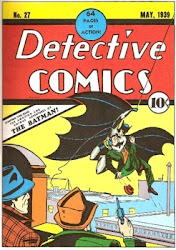 When we easy-living post-mod children of the post-war boom reach back for handfuls of cultural humus to ground our own reveries, it’s usually twenties-thirties modern. Our conscious backstop is WWII, which mobilized the men, transformed the homefront, and lived on through the cold war where we wore the white hat globally. This began to break apart in the sixties but not fully and not soon enough to save them with the black hat. However baby boom myth preferred to portray the 1950s humus as sterile, and this more recent golden age wasn’t made much use of until the punk era had run through its immediate sources and found itself fascinated with Johnny Cash, Link Wray, et. al. So the attachment to the Roaring Twenties and the Depression tends to be reflexive. Harry Smith began it for us in the early 1950s with his excavation and representation of songs and art from back before the war. This continued thru folk music and the blues revival. And early hippie-era graphics often trolled the twenties for inspiration; R. Crumb is famously only interested in the twenties. And just a year ago music photographer Jenny Lens was insisting on the silent vamps influence on the seventies punk female look – Exene in particular.
When we easy-living post-mod children of the post-war boom reach back for handfuls of cultural humus to ground our own reveries, it’s usually twenties-thirties modern. Our conscious backstop is WWII, which mobilized the men, transformed the homefront, and lived on through the cold war where we wore the white hat globally. This began to break apart in the sixties but not fully and not soon enough to save them with the black hat. However baby boom myth preferred to portray the 1950s humus as sterile, and this more recent golden age wasn’t made much use of until the punk era had run through its immediate sources and found itself fascinated with Johnny Cash, Link Wray, et. al. So the attachment to the Roaring Twenties and the Depression tends to be reflexive. Harry Smith began it for us in the early 1950s with his excavation and representation of songs and art from back before the war. This continued thru folk music and the blues revival. And early hippie-era graphics often trolled the twenties for inspiration; R. Crumb is famously only interested in the twenties. And just a year ago music photographer Jenny Lens was insisting on the silent vamps influence on the seventies punk female look – Exene in particular.
But in this ongoing borrowing the sunnier appetite of fans is in a footrace with the sour drive of university adjuncts as they interrogate the hero or at least knock the white hat off him. The collegiate plaintiffeoisie has some ongoing need to pose as their own supercritic hero dragging into the dock some stand-in for their parents. American WWII victory culture was that intimidating, and the burdens of the cold war that intolerable to the generations that followed, suspecting any achievements of their own must necessarily pale in comparison, or even have questionable authorship given the headstart in a clear field the thirties-forties provided us.
*
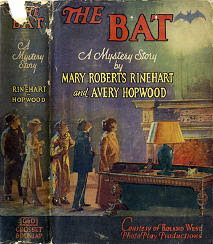
The Superman franchise has been easier to relaunch and so it has greater continuity through comics, movies, television, merch. Bob Kane’s answer to Superman bears a heavier load, and as a creature of the night can even be sucked into that still spreading after-the-fact revisionist applied faux category, Noir, from which there is now no escape. Batman and Johnny Cash both got caught on the goth conveyer-belt to noir at the end of the nineties. If all those gospel recordings and all his praying couldn’t save the man in black what chance did the Batman have?
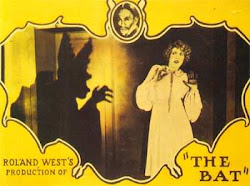 Superman had a six-year gestation before anyone saw him, whereas Batman was ordered up one weekend to reproduce Superman’s sales figures. If Jerry Siegel and Joe Shuster pulled from science fiction and the Jewish legend of the Golem, Kane pulled rather from films: two Roland West films adapted from the 1922 Broadway hit, The Bat, as well as Douglas Fairbanks’ The Mark of Zorro (1920). West’s 1926 version featured sets by William Cameron Menzies and was shot by Arthur Edeson with Gregg Toland apprenticing; West remade his own film as a talkie titled, The Bat Whispers (1930). Both films are visually innovative comic mysteries -- what used to be called “old dark house” pictures. In these films (and the play) a master thief wears the mask and cape. He bait’s the police with mocking notes and the earlier film even features a bat signal. Fairbanks played Don Diego as a louche fop so as to better disguise the masked, stout-hearted, acrobatic Zorro. Superman’s Clark Kent alter ego tracks closer to Zorro, both feature comic relief as women despair over the uselessness of the alter ego, wishing he might be more like the hero. The mask Bruce Wayne wears to become Batman had an interesting pull on young boys and their heroic fantasies. The mask promises that one’s deeds will speak for themselves and reveal one’s true identity, rather than the grubby little kid one actually is. The Lone Ranger used this aspect as well.
Superman had a six-year gestation before anyone saw him, whereas Batman was ordered up one weekend to reproduce Superman’s sales figures. If Jerry Siegel and Joe Shuster pulled from science fiction and the Jewish legend of the Golem, Kane pulled rather from films: two Roland West films adapted from the 1922 Broadway hit, The Bat, as well as Douglas Fairbanks’ The Mark of Zorro (1920). West’s 1926 version featured sets by William Cameron Menzies and was shot by Arthur Edeson with Gregg Toland apprenticing; West remade his own film as a talkie titled, The Bat Whispers (1930). Both films are visually innovative comic mysteries -- what used to be called “old dark house” pictures. In these films (and the play) a master thief wears the mask and cape. He bait’s the police with mocking notes and the earlier film even features a bat signal. Fairbanks played Don Diego as a louche fop so as to better disguise the masked, stout-hearted, acrobatic Zorro. Superman’s Clark Kent alter ego tracks closer to Zorro, both feature comic relief as women despair over the uselessness of the alter ego, wishing he might be more like the hero. The mask Bruce Wayne wears to become Batman had an interesting pull on young boys and their heroic fantasies. The mask promises that one’s deeds will speak for themselves and reveal one’s true identity, rather than the grubby little kid one actually is. The Lone Ranger used this aspect as well.
 Batman debuted in Detective Comics in 1939, one year after Superman. Dick Tracy had debuted in Tribune papers in 1931. It was Chester Gould’s daily comic strip that set the crime-fighting scene and discovered readership appetite for an implacable force for justice against criminal impunity. This appetite was struck in twenties Chicago. The big town was an instant city of new money and immigrant poverty -- the biggest crap game ever, where America bet that masses of Catholics could be made over into Americans, and that blacks might had a future here as well. Prohibition had failed to dent Catholic drinking habits, and they re-charged cracker racism of the south with grave peasant fear. Marcus Garvey was promoting repatriation to Liberia in the twenties. It wasn’t clear this bet would be won. But Bismarck was right, “God has a special providence for fools, drunks and the United States of America,” though he too (Bismarck, that is) had his doubts about Catholics. America’s enemies at home and abroad would thus do well to surrender, drop rifle or pen and emigrate or immigrate as the case may be. The immigrants that did come and the blacks who came north understood finely in a first-person risk-reward sense that beneath all the roiling cruelty of the city a better deal might be had.
Batman debuted in Detective Comics in 1939, one year after Superman. Dick Tracy had debuted in Tribune papers in 1931. It was Chester Gould’s daily comic strip that set the crime-fighting scene and discovered readership appetite for an implacable force for justice against criminal impunity. This appetite was struck in twenties Chicago. The big town was an instant city of new money and immigrant poverty -- the biggest crap game ever, where America bet that masses of Catholics could be made over into Americans, and that blacks might had a future here as well. Prohibition had failed to dent Catholic drinking habits, and they re-charged cracker racism of the south with grave peasant fear. Marcus Garvey was promoting repatriation to Liberia in the twenties. It wasn’t clear this bet would be won. But Bismarck was right, “God has a special providence for fools, drunks and the United States of America,” though he too (Bismarck, that is) had his doubts about Catholics. America’s enemies at home and abroad would thus do well to surrender, drop rifle or pen and emigrate or immigrate as the case may be. The immigrants that did come and the blacks who came north understood finely in a first-person risk-reward sense that beneath all the roiling cruelty of the city a better deal might be had.
Mayor Anton Cermak was one of those immigrants; elected in 1931 he made a political machine out of the ethnic stew spilling through the neighborhoods. Convention still has it that Giuseppe Zangara was aiming for Franklin Roosevelt went he shot and killed Cermak but FDR wasn’t the President yet and wasn’t standing near Cermak. In Chicago, given the pace of events ahead of Prohibition’s end and the approaching World’s Fair, no-one doubted Capone, on his way to jail, and Nitti, who’d survived
 assassination by Cermak’s extra-legal thugs, had sent the Sicilian sharpshooter to hit “Pushcart Tony.” Chicago was the capitol of the country until FDR’s New Deal and the War resized the Federal government only to see the national imagination shift west to Los Angeles come the forties and fifties.
assassination by Cermak’s extra-legal thugs, had sent the Sicilian sharpshooter to hit “Pushcart Tony.” Chicago was the capitol of the country until FDR’s New Deal and the War resized the Federal government only to see the national imagination shift west to Los Angeles come the forties and fifties.
The superhero phenomenon arose from young sons shamed by their immigrant fathers who couldn’t speak English and worked unheroic though often quite dangerous jobs. They kept their heads down while bootleggers and white slavers fought for streets in a wide open town. They understood only the old country ways and saw this crossfire as a kind of WWI redux – a Chicago World War – fought by ethnic mafias rather than states – the Italians, Poles, Czechs, Slovaks, Serbs, Croats, Irish, Jews, and blacks all had their rooting interests in the crime-family battles. So did the Pols and the Police, and sometimes even the miniscule wasp elite. Newsprint was the cultural currency. And little boys burned for a response to this impunity and from the early thirties they found it in Dick Tracy, radio’s “Lone Ranger” and “Green Hornet”, Superman, and Batman. Picture those kids helping their European-born or former sharecropper fathers read Dick Tracy at the end of the day.
Chester Gould introduced high-tech gadgets and super-villains but Tracy himself was not quite a superhero; the other superheroes would be more fully owned by the kids.
*
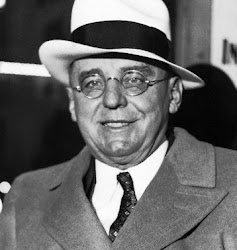
 Frank Miller, a lover of Gotham, has his Dark Knight Batman-reset nod to this Chicago source with a reference to Commissioner Gordon’s “sketchy” early days as a Chicago cop – now there’s some story loam, Tracy’s departmental rival. And Batman’s Gotham continues to feature the human scale surface street bridges one sees rising and lowering over the Chicago River rather than the few massive arterial bridges that barely connect Manhattan to the other boroughs. But Miller picked the right superhero to adapt. The original can be improved. Kane eventually built up a distinctive gallery of arch-criminals, but graphically, only the title-page portraits of “the Batman” really hit like arcane icons, and DC Comics didn’t dare commit graphically to a night-world of black-and-white and so Batman jumps around in an incongruously brightly colored night. None of Hollywood’s black-and-white chapter-serials based on these comics were any good, but the four Dick Tracy features made in the mid-40s look great and point to the kind of production Batman in particular would’ve benefited from (these were directed by William Berke, Gordon Douglas, and John Rawlins). Another missed bet was the quick addition of sidekick Robin which insulted all but the youngest reader. If Batman can’t be a brooding loner in the night, who can be? Robin appears one year into Batman’s run in Detective Comics when he is still battling run-of-the-mill criminals and syndicates. One issue later is the first free-standing Batman No. 1 comic and it introduces The Joker.
Frank Miller, a lover of Gotham, has his Dark Knight Batman-reset nod to this Chicago source with a reference to Commissioner Gordon’s “sketchy” early days as a Chicago cop – now there’s some story loam, Tracy’s departmental rival. And Batman’s Gotham continues to feature the human scale surface street bridges one sees rising and lowering over the Chicago River rather than the few massive arterial bridges that barely connect Manhattan to the other boroughs. But Miller picked the right superhero to adapt. The original can be improved. Kane eventually built up a distinctive gallery of arch-criminals, but graphically, only the title-page portraits of “the Batman” really hit like arcane icons, and DC Comics didn’t dare commit graphically to a night-world of black-and-white and so Batman jumps around in an incongruously brightly colored night. None of Hollywood’s black-and-white chapter-serials based on these comics were any good, but the four Dick Tracy features made in the mid-40s look great and point to the kind of production Batman in particular would’ve benefited from (these were directed by William Berke, Gordon Douglas, and John Rawlins). Another missed bet was the quick addition of sidekick Robin which insulted all but the youngest reader. If Batman can’t be a brooding loner in the night, who can be? Robin appears one year into Batman’s run in Detective Comics when he is still battling run-of-the-mill criminals and syndicates. One issue later is the first free-standing Batman No. 1 comic and it introduces The Joker.
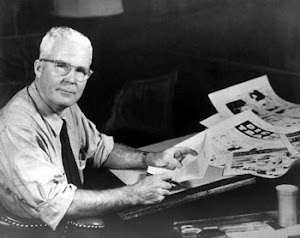 Frank Miller in his introduction to his collection Absolute Dark Knight makes veiled reference to Frederick Wertham’s 1954 anti-comic book polemic, Seduction of the Innocent, where the good doctor accused Batman comics of being “psychologically homosexual.” In the mid-sixties, The Realist revisited Wertham for laughs but also for real in John Cochran’s “Batman and Robin were lovers.” Of course in the sixties we may be juvenile but we aren’t authentically modern anymore, though the comics are still being issued and in fact the pop zeitgeist-grabbing “Batman” television show is just around the corner. Mad Magazine, The Realist and underground comics are publishing funny, derisive, lewd versions of famous daily strip and comic book characters and it seems the backroom cynicism of politics, newsroom, and showbiz has invaded our living rooms. I often think of Jack Brewer’s poem for the Saccharine Trust piece, “Emotions and Anatomy”, which ends:
Frank Miller in his introduction to his collection Absolute Dark Knight makes veiled reference to Frederick Wertham’s 1954 anti-comic book polemic, Seduction of the Innocent, where the good doctor accused Batman comics of being “psychologically homosexual.” In the mid-sixties, The Realist revisited Wertham for laughs but also for real in John Cochran’s “Batman and Robin were lovers.” Of course in the sixties we may be juvenile but we aren’t authentically modern anymore, though the comics are still being issued and in fact the pop zeitgeist-grabbing “Batman” television show is just around the corner. Mad Magazine, The Realist and underground comics are publishing funny, derisive, lewd versions of famous daily strip and comic book characters and it seems the backroom cynicism of politics, newsroom, and showbiz has invaded our living rooms. I often think of Jack Brewer’s poem for the Saccharine Trust piece, “Emotions and Anatomy”, which ends:
“Because the world is perverse
We must live through our imaginations.
When our imaginations become perverse
All that is left is… is… is…”
(V.A. – The Blasting Concept, Vol. II)
 Miller responds to the over- and underground subterfuge by enlisting a female Robin (the original Robin, Dick Grayson, has gone bad) which contemporizes his aging Batman’s world, adding sexual tension to Bruce Wayne’s lifelong commitment to honor his parents, murdered back in the roaring twenties of impunity. Miller is grounded in the original real thing of comics, so while influenced by the underground comics of the sixties and seventies he doesn’t surrender to it. He writes that human nature is “immutable”, and with this simple declaration he throws off much of the worst political pretense of the last century. The sixties version of that pretense was dumbed-down New Left cant and proffered by poli-sci washouts or pseudo-artists who moved in the wake of the old left, the civil rights movement, rock and roll or Crumb. The hippies sought the natural man until one named Charlie showed up. Face it, the only New Man possible in the world of comic book crime-fighters is the next hideous black-hearted mutant announcing himself with some insane outrage – like Manson, id in full effect.
Miller responds to the over- and underground subterfuge by enlisting a female Robin (the original Robin, Dick Grayson, has gone bad) which contemporizes his aging Batman’s world, adding sexual tension to Bruce Wayne’s lifelong commitment to honor his parents, murdered back in the roaring twenties of impunity. Miller is grounded in the original real thing of comics, so while influenced by the underground comics of the sixties and seventies he doesn’t surrender to it. He writes that human nature is “immutable”, and with this simple declaration he throws off much of the worst political pretense of the last century. The sixties version of that pretense was dumbed-down New Left cant and proffered by poli-sci washouts or pseudo-artists who moved in the wake of the old left, the civil rights movement, rock and roll or Crumb. The hippies sought the natural man until one named Charlie showed up. Face it, the only New Man possible in the world of comic book crime-fighters is the next hideous black-hearted mutant announcing himself with some insane outrage – like Manson, id in full effect.
Miller loves the melodrama of the comics form and speaks in an interview of hoping to cause his reader to slow down for appreciation of the art against the impulse to race along the storyline. A story chopped into a procession of frames colliding and sparking off each other makes the comic a better illustration of Eisenstein’s theory of montage than film, because the motion picture, or living picture as it was called in its early history, finds its initial power in its framing of motion. But when a comic book run is collected and reprinted in bound editions, much less an extravagant, large, boxed, hard cover glossy re-framing of form like this edition, it’s cheap glory is corrupted by promising too much. The graphic-novelization of comics is a wrong turn as sure as Cinerama was for cinema. I never saw the original issue of Miller’s work and I’m sure those who have, value the high-tone reproductions of the original artwork now available but in terms of storytelling it shifts the weight away from story and the normal porn of form to the distracting fetish of printing specs.
*

In Miller’s Batman stories it’s the corruption of truth that the electronic news-media yields and wields that concerns him. In Kane’s original, newspapermen are merely bumbling fools blaming Batman for crimes he is hot on the trail solving. Now the omnipresent faces on screens seem a willful chorus of some sealed-off collective id -- reporters barely see the streets and by the end it's “News in the Nude”, cutting to spokesmen, fuming heads and a holographic president.
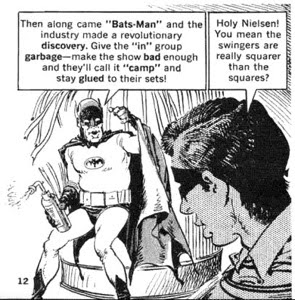 In The Dark Knight Returns (1986) Miller placed a middle-aged Batman in a seventies New York that inspired films like Death Wish (1974), The Warriors (1979), Defiance (1980), and Escape from New York (1981). In The Dark Knight Strikes Again (2001-2) Batman is fully aged and now the internet deepens the corruption of truth as the superhero’s own fans band together to counter television’s calumny and succeed mostly in presenting one more obstacle to necessary action by the hero. Miller catches a New York at the end of Mayor Rudy Giuliani’s tenure. The one-party polity had turned to a Republican who was seen as a last hope crime-fighter, and amazingly he delivered and head-manned newly ascendant Gotham to the point that even the suits claim they miss the old Times Square. As reward Giuliani was exiting a lame-duck laughingstock, dragging himself towards divorce and chemotherapy. And then super-villains attacked from their secret lair on September 11th.
In The Dark Knight Returns (1986) Miller placed a middle-aged Batman in a seventies New York that inspired films like Death Wish (1974), The Warriors (1979), Defiance (1980), and Escape from New York (1981). In The Dark Knight Strikes Again (2001-2) Batman is fully aged and now the internet deepens the corruption of truth as the superhero’s own fans band together to counter television’s calumny and succeed mostly in presenting one more obstacle to necessary action by the hero. Miller catches a New York at the end of Mayor Rudy Giuliani’s tenure. The one-party polity had turned to a Republican who was seen as a last hope crime-fighter, and amazingly he delivered and head-manned newly ascendant Gotham to the point that even the suits claim they miss the old Times Square. As reward Giuliani was exiting a lame-duck laughingstock, dragging himself towards divorce and chemotherapy. And then super-villains attacked from their secret lair on September 11th.
Miller writes of his Dark Knight stories,
“Much of what I was after was to use the crime-ridden world around me to portray a world that needed an obsessive, Herculean, half-maniac genius to bring order. But that was only half the job. I saved my nastiest venom… for the vapid, pandering talking heads who so poorly chronicled the gigantic conflicts of the time. What would these little people do if giants walked the Earth? How would they regard a powerful, demanding, unrepentant hero? Or a villain whose soul is as black as death? Fifteen years passed. I found out. I was halfway thru The Dark Knight Strikes Again when the Twin Towers collapsed and thousands of my neighbors were slaughtered.” (Absolute Dark Knight, DC)
 The Dark Knight Strikes Again couldn’t thereafter be the “affectionate romp” he intended, but it was too late to change its title to, say, The Dark Knight Strikes Out. While the art’s color shifts after 9/11 into an unhinged computer-chromaticized scheme -- not quite air-brush minimal, not quite psychedelic -- the story skids out into an end-times for the hero as Batman -- Bruce Wayne under mask and cape -- begins to break down due to age and the pressure of a seemingly hopeless battle. The overwhelming weakness of the city around him means even the legion of attending superheroes can make no difference as each that throws in with Batman and Robin are quickly preoccupied with simple survival. They mostly do.
The Dark Knight Strikes Again couldn’t thereafter be the “affectionate romp” he intended, but it was too late to change its title to, say, The Dark Knight Strikes Out. While the art’s color shifts after 9/11 into an unhinged computer-chromaticized scheme -- not quite air-brush minimal, not quite psychedelic -- the story skids out into an end-times for the hero as Batman -- Bruce Wayne under mask and cape -- begins to break down due to age and the pressure of a seemingly hopeless battle. The overwhelming weakness of the city around him means even the legion of attending superheroes can make no difference as each that throws in with Batman and Robin are quickly preoccupied with simple survival. They mostly do.
The superhero of the world of comics is a profane version of the story of Christ, and not far removed from those mortals who intervened in the histories of their similarly collapsing nations -- Fujimori, Pinochet, Franco -- and were called fascists for their trouble. The simple question, Compared to what?, comes to mind. But the world of comics is not national, it must be a single city -- the city as planet. It’s a mistake to acknowledge Chicago or Washington as Miller does. Cataclysm in Gotham reminded its citizens that they needed Giuliani, but he never should’ve run for President; President of what? For him there is nothing but his city. There are limitations to the pop metaphysics of comics and they are not forgiving. The world they describe implodes at the slightest attempt to redeem their twenties inheritance in sixties social-science terms. In eighties London, Alan Moore and David Lloyd tried to rationalize terror in V for Vendetta by turning Guy Fawkes (a militant Catholic to the right of Franco) into a Nechaev of style and taste who delivers freedom via propaganda-by-the-deed, the destruction of the structures of bourgeois democracy, something of an idée fixe of both national socialism and international socialism until the cataclysm of the forties. There still are idiots running around London in Moore’s Fawkes masks. Moore and Lloyd surrender to sixties-seventies subterfuge and they make Miller look like a genius for accepting that comics can bear no redeeming beyond what a son can describe to his father in this strange new world.
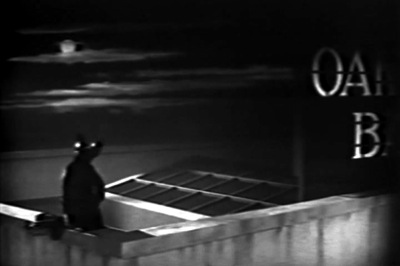
(illustrations: Dark Knight and Superman by Frank Miller; Detective Comics May 1939; Mary Roberts Rinehart & Avery Hopwood’s The Bat, 1920; Roland West’s “The Bat”; William Cameron Menzies’ bat signal, 1926; Roland West’s “The Bat Whispers”; Chicago Mayor Anton Cermak; Giuseppe Zangara; Chester Gould; Dick Tracy comic book; Bob Kane’s “The Batman”; Mad Magazine’s “Bats-man”; Miller's "Dark Knight Returns"; Roland West’s “The Bat.”)
Thanks to Ben Schwartz and the L.A. Review of Books.


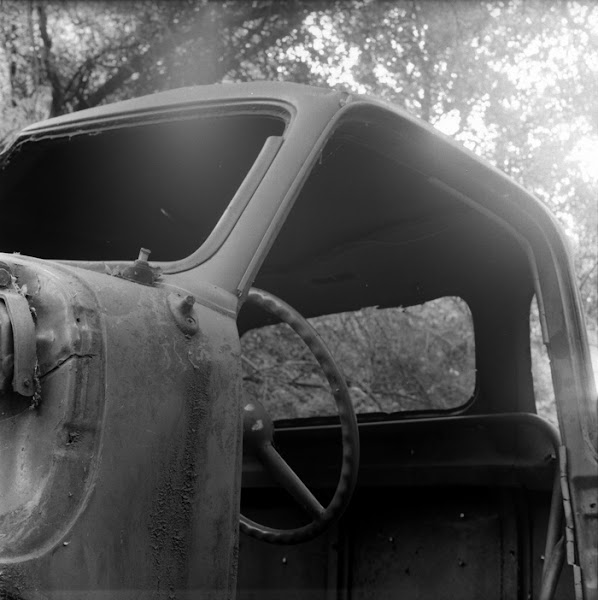
Photos by Chris Collins
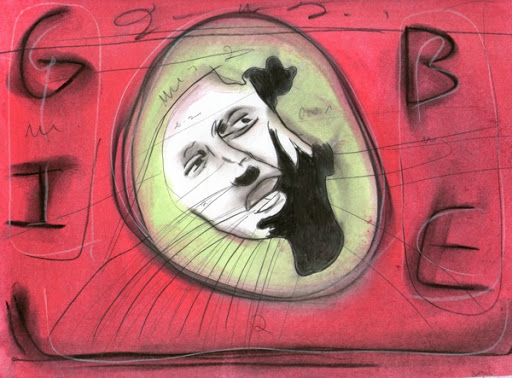
Drawing by James Fotopoulos
From the Medicine Bow Desk of Joe Carducci…
WSJ: "Notable & Quotable".
“From a speech by Howard Buffett, a congressman from Nebraska (and father of Warren Buffett), reprinted in the Freeman, December 1956:
‘The last 40 years have seen a gigantic expansion of political power over economic affairs by the federal government. This change is linked by many scholars to the passage of the income tax law in 1913. This law revolutionized the taxing system in two ways:
1. It gave the government new powers over the economic status of the individual. This change has curtailed the ability of the individual to achieve economic independence.
2. The part of his production taken from the producer cumulatively increases the power of the federal government proportionately with the increase in its income. This power is not created; it is simply taken away from the people. . . .
The transfer of economic power into political hands takes many forms. In 1932 about 2.5 million people received a check from the government every month. Today about 20 million receive a government check every month. What is the effect on the freedom of this great segment of our people being more or less dependent on the political authorities for their daily bread? . . .’”
***
Conrad Black in National Review, "Buffett Squandering His Chance".
“No reasonable person debates Warren Buffett’s talents any more than Barbra Streisand’s, but in his case, he knows what he is saying is bunk, and he should know that most of his audience is suspicious of his motives. His comments in the New York Times this week on why he should be taxed more are spurious, and presumably just another public-relations exercise by a mega-billionaire who sees what a shambles his friends in the administration are making, and is tilting farther left to preempt public-relations problems. His years of padding around university campuses with Bill Gates in their corduroy trousers and viyella shirts explaining that they weren’t really interested in money were hard enough to take, but this next act, solo, as a slimmed-down Santa without beard, sleigh, or red uniform is wearing thin. Though I consider the spirit of J. P. Morgan’s famous ‘The public be damned!’ to be somewhat dated and in-egalitarian, it did… at least have a ring of sincerity. As President Bush II said, in response to Buffett and others, the Treasury will deposit their checks, if they are so concerned that they want to contribute more to national revenues.”
***
Christopher Caldwell in FT, "Why Buffett is wrong about soaking the rich.".
"As Mr Buffett puts it, those who 'make money with money' are treated better than those who 'make money from a job'. In saying this, Mr Buffett subscribes to the religious understanding of money that was universal in the Christian world before the rise of Florentine banking (and of Protestantism) and has been restated in our own time by practitioners of Islamic finance. Since money is not alive the way people are, it should not produce and reproduce the way people do. It is a powerful and even a beautiful argument, but there are two problems with it. The first is that just because something is time-honoured moral wisdom does not make it workable captialist fiscal policy. Economics, in fact, prides itself on throwing aside such wisdom. It is inconsistent to argue on Christian grounds that paying interest on 'sterile' money is sinful and then to argue on Keynesian grounds that thrift in a downturn is inefficient. There is a second inadequacy in Mr Buffett's suggestion. Polls show a majority of Americans want rich people's taxes raised. But soaking billionaires will not suffice to address the deficit and debt."
***
Tim Cavanaugh in Reason, "How Long Will It Take Keynes to Die?".
“This is the kind of laziness that sets in when you never have to entertain a serious challenge to your ideas. It’s remarkable given that the ballyhooed and short-lived return of Keynes was not merely rhetorical. These ideas were put into action, at a cost of trillions of dollars that will someday have to be paid back. The result was either a recovery too microscopic to notice or no recovery at all. Everywhere except the Times, people have noticed. The rise of the Tea Party, the three-fourths majority in favor of a federal spending cap, and the midterm election results were all evidence that Keynesian intervention is no longer a marketable idea. There are few things less relevant than a newspaper, but many people, possibly hundreds, still take The New York Times seriously, and they’re being disserved when the paper misses an important shift in economic theory. The long-defunct economist was brought out for a final bow — a courtesy the Muscular Dystrophy Association won’t even extend to Jerry Lewis — and the result left audiences cold the world over. Keynesian mysticism — with its fancy equations, its cramped vocabulary of “liquidity traps” and “irreducible uncertainty,” and its pre-Copernican belief that a group of wise men in a central office can decide what “aggregate demand” should be among hundreds of millions of people — is over.”
***
Luca Rastello & Stefano Parola in NYT, "How Italy Is Adjusting".
“As so often happens in Italy, anxiety manifests itself in individualistic survival strategies. People turn away from government and broader society, fall back on family and clan loyalties and the informal sector. Sociologists call the result ‘amoral familism,’ a term Edward C. Banfield coined in the 1950s. There are upsides and downsides to this phenomenon. Italians have a great capacity for reconstruction after hard times — as after the Second World War, when the country emerged from ruins to become one of the most industrialized in the world. We tend to associate those resurrections with what we call the ‘art of muddling through,’ of which we are masters. It’s the capacity to be flexible in the face of change — something families tend to do better than governments. But this is allied to a deep mistrust of government and the public sector. As many sociologists have pointed out, localism and clannishness are the enemies of an open and meritocratic society. Access to the professions is considered almost a hereditary privilege here. And tax evasion is seen as a legitimate defense against an inefficient state.”
***
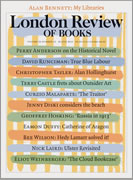 Slavoj Zizek at London Review of Books, "Shoplifters of the World Unite".
Slavoj Zizek at London Review of Books, "Shoplifters of the World Unite".
“We live in cynical times, and it’s easy to imagine a protester who, caught looting and burning a store and pressed for his reasons, would answer in the language used by social workers and sociologists, citing diminished social mobility, rising insecurity, the disintegration of paternal authority, the lack of maternal love in his early childhood. He knows what he is doing, then, but is doing it nonetheless. It is meaningless to ponder which of these two reactions, conservative or liberal, is the worse: as Stalin would have put it, they are both worse, and that includes the warning given by both sides that the real danger of these outbursts resides in the predictable racist reaction of the ‘silent majority’. One of the forms this reaction took was the ‘tribal’ activity of the local (Turkish, Caribbean, Sikh) communities which quickly organised their own vigilante units to protect their property. Are the shopkeepers a small bourgeoisie defending their property against a genuine, if violent, protest against the system; or are they representatives of the working class, fighting the forces of social disintegration? Here too one should reject the demand to take sides. The truth is that the conflict was between two poles of the underprivileged: those who have succeeded in functioning within the system versus those who are too frustrated to go on trying.”
***
Harriet Sergeant in Spectator, "These rioters are Tony Blair’s children".
“On the third day of the London riots I received a telephone call from Mash, a member of a Brixton gang who I befriended three years ago. He was standing outside an electronics shop in Clapham, watching the looting. I could hear shouts, glass breaking but never a police siren. I urged him to go home. ‘Harri man,’ he remonstrated, his voice hoarse with emotion, ‘You don’t get to do this every day. You do your thing, and you don’t get arrested. It’s wild and exciting. These few days, it’s our time.’ The riots engulfing areas of London and other cities this week are not about poverty or race. They are about young men like Mash who are barely literate, unemployed, with no future and nothing to lose. For them it is suddenly a dream come true. Their favourite video games have become a reality. They have got what they never had before – power, a sense of achievement and lots of goodies. Most of us want the same thing. The difference is we can get them without setting London ablaze.”
***
Max Hastings in FT, "Charlatans lead us into the lean years".
“I question whether such rationality is the norm among the British, American and European peoples. Our societies cherish a gross sense of entitlement. We have also become wedded to the doctrine, profitably promoted by millions of lawyers, that for every misfortune someone must be indicted as blameworthy. Sir Mervyn King, governor of the Bank of England, said in a recent speech that Britain is at the midpoint of ‘seven lean years’. When I recently put it to a central banker that most western nations seem more likely to be starting 70 lean years, I was shocked by the readiness with which he assented.”
***
William Wallis in FT, "Why Africa is leaving Europe behind".
“Africa has been enjoying this reversal of roles. As rioting spread from London to other cities, South Africa‘s foreign ministry took the unusual step of issuing a travel advisory warning its citizens against visiting the UK. There was also retaliation for past jibes about their country‘s capacity to organise the 2010 football World Cup, by questioning whether London can be trusted to host a safe Olympics.”
***
John Plender in FT, "Bond vigilantes keep a close eye on ability to print money".
“The underlying logic is that no country defaults on its domestic bonds if it retains the right to set the printing presses in motion. Yet it seems counter-intuitive that bond markets, with their traditional fear of inflation, should punish a country for not being able to debase its currency. The demise of this conventional market wisdom is one of the achievements, for want of a better word, of European Monetary Union…. As a correspondent to the Financial Times wrote last week… the Weimar Republic would presumably have been entitled to a triple A rating since it was perfectly capable of repaying its debts, even though the hyper-inflated money used for the task would have been close to worthless.”
***
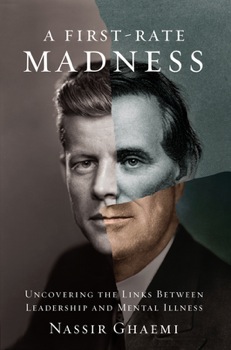 Thomas Mallon in NYTBR on Nassir Ghaemi’s book, A First-Rate Madness.
Thomas Mallon in NYTBR on Nassir Ghaemi’s book, A First-Rate Madness.
“‘There is no Kennedy curse. There is a Kennedy gene — for hyperthymia — that is both a curse and a blessing.’ The president misused anabolic steroids as well as amphetamines until a ‘medical coup d’état,’ headed by a White House doctor, George Burkley, and carried out some time before the Cuban missile crisis, got Kennedy on the proper regimen of prescription drugs. The result, Ghaemi believes, paraphrasing Kennedy’s urologist, was ‘a spectacular psychochemical success.’ From it the author seems to derive a kind of contact high, one that sends him on a fanciful flight of alternate history: ‘The military presence in Vietnam, later disastrous, was a mistake made in 1961, when Kennedy was medically ill and psychiatrically erratic. By 1963, Kennedy expressed reservations about further involvement in that conflict. Had he lived, he probably would not have responded the way Lyndon Johnson did.’ Or he would have. Ghaemi does nothing by halves. Admitting that his next psychological autopsy is a ‘delicate’ matter, he moves on from Kennedy’s case to Hitler’s. ‘Up to 1937, I think his moderate bipolar disorder influenced his political career for the better — fueling his charisma, resilience and political creativity.’ Later, though, Hitler’s personal physician, Theodor Morell, began injecting the Führer with amphetamines, thereby lighting ‘a fuse that exploded the entire world.’ Ghaemi would have rendered a malpractice judgment at Nuremberg.”
***
Edward Wong in NYT, "Photo Turns U.S. Envoy Into a Lesson for Chinese".
“A photograph taken last Friday of Gary F. Locke, the new United States ambassador to China, buying coffee with his 6-year-old daughter and carrying a black backpack at a Starbucks in the Seattle airport has gone viral on the Chinese Internet. The seemingly banal scene has bewildered and disarmed Chinese because they are used to seeing their own officials indulge in privileged lives often propped up by graft and bribery and lavish expense accounts…. Mr. Locke and his family were waiting to fly to Beijing when a Chinese-American businessman shot the photograph and posted it on Sina Weibo, a popular Chinese social networking site. It has been reposted over 40,000 times and has generated thousands of comments. State news organizations have weighed in with favorable articles about Mr. Locke, a former governor of Washington State and President Obama’s first Commerce secretary, who on Tuesday presented his credentials to President Hu Jintao of China to start his posting. The first impression from the Starbucks episode has been bolstered by another photograph that shows Mr. Locke, his wife, Mona, and their three children carrying their own luggage after landing at Beijing Capital International Airport. Chinese who saw them then spread the word that the family had gotten into an anonymous minivan because a formal sedan that had been sent to pick them up was too small. ‘To most Chinese people, the scene was so unusual it almost defied belief,’ Chen Weihua, an editor at China Daily, an official English-language newspaper, wrote in an article Wednesday. Cheng Li, a scholar at the Brookings Institution who studies Chinese elite politics, said in an e-mail: ‘Ambassador Locke’s photo contrasts sharply with the image of the Chinese officials who often live in a secret, insulated, very privileged fashion.’”
***
Scott Kilman & Brian Spegele in WSJ, "Chinese Hunger for Corn Stretches Farm Belt".
“China's influence on corn demand underlines how its fast-growing economy is reshaping global commerce. The nation, with its growing population of 1.3 billion people, has been a major player in commodities markets in recent years. China already buys about a quarter of all U.S. soybeans. But its sudden demand for corn caught many off guard. China, which hadn't been a net importer of corn for 15 years until last year, has a vast corn belt of its own and for many years strove to be self-sufficient. And because China is secretive about the levels of commodities it holds in its strategic reserves, the rest of the market can only guess what its supply needs are. Many attribute the larger-than-expected demand to a growing middle class that is changing its tastes more quickly than anticipated. As the Chinese population becomes wealthier, for example, it is eating more pork. And the Chinese government is pushing its farmers to adopt Western methods of raising their pigs, including feeding them more corn. Citizens are also slurping up juices and other products that include corn-based sweeteners: Coca-Cola Co. said that its volume in China spiked 21% in the second quarter.”
***
 Stephen Kinzer in New York Review of Books, "Triumphant Turkey?".
Stephen Kinzer in New York Review of Books, "Triumphant Turkey?".
“Shortly before Erdogan won his first national election in 2002, prosecutors charged that he was plotting to subvert the secular order, and asked the Constitutional Court to shut down his party and ban him from politics. He survived by a single vote. That apparently led a cabal of officers to discuss the possibility of deposing him by force. Documents implicating these officers and others in a host of crimes — not just plotting to overthrow the government, but also organizing horrific murders like that of the Turkish-Armenian journalist Hrant Dink in 2007 — have been leaked to the press. The first hearing in 2008 set off a cascade of legal charges, an indictment that runs to several thousand pages, and the arrest of hundreds of suspects, including at least thirty active-duty generals. The plot to destabilize the country, and the cases connected to it, are popularly known as ‘Ergenekon,’ a reference to a mythic Turkic homeland and the name that plotters allegedly gave to their subversive plan. Many Turks greeted the opening of this case with both astonishment and jubilation. Investigating the military and its corrupt allies in the judiciary and bureaucracy was widely seen as a major step toward consolidating democracy. As the case has dragged on, however, it has taken on a different tinge. The authenticity of some incriminating documents has been challenged. Prosecutors have cast their net so widely that people have begun to wonder whether the true purpose of the case is to punish conspirators or to intimidate critics of the government. Since the government has been slowly replacing prosecutors with people it favors, there is suspicion that politics is once again intruding into the judiciary.”
***
David Gardner in FT, "Turkey’s newly faltering foreign adventures".
“It is far from obvious that the Erdogan government’s vaunted ‘zero problems with the neighbours’ policy passes muster. When Mr Erdogan and his AKP party were re-elected for the third successive time in June, his triumphal seemed to know no bounds. The result, he proclaimed, was a victory ‘for Bosnia as much as Istanbul, Beirut as much as Izmir, Damascus as much as Ankara’. Within days, thousands of Syrians were streaming across the Turkish border, seeking refuge from the savagery uncaged by their president, Bashar al-Assad.”
***
Mary O’Grady in WSJ, "Bernanke Reflates Kirchner’s Presidency".
“The easiest explanation for Mrs. Kirchner‘s strong showing is the economy, which grew 9%-10% in 2010 and is on track to grow more than 8% this year. Primary government spending (before interest on the debt) is no small part of this. As a percentage of gross domestic product it averaged 23% from 2000 to 2004. That average in the years 2005 through 2008 was around 27%. But this year it is on track to 38%, a figure higher than in socialist Venezuela or Ecuador. Where is all the money coming from? That‘s where the luck comes in. This perpetual-motion machine wouldn‘t be working if Mrs. Kirchner wasn’t the beneficiary of Fed Chairman Ben Bernanke’s easy money policy. That policy has helped push up global soybean prices and created a farm export boom. The strong flow of dollars combined with the central bank’s weak peso policy has produced a windfall of monetary stimulus. All this funny money has pushed up internal demand and, when combined with increased levels of protectionism, has stimulated the need for import substitution which is being met by domestic production.”
***
 Hillary Burke & Malena Castaldi at MercoPress.com, "Feisty Uruguay wins respect from neighbours and investors".
Hillary Burke & Malena Castaldi at MercoPress.com, "Feisty Uruguay wins respect from neighbours and investors".
“Being sandwiched between South America's biggest economies ‘is like being small in a pack of big dogs. You have to bark the loudest and act the toughest or else you don't exist,’ said Ignacio Otegui, head of Uruguay's construction chamber. Uruguay demands respect from its neighbours but also earns it from outsiders, who value its stable institutions, low corruption levels and respect for the rule of law -- setting it apart from many others in Latin America. Foreign direct investment in Uruguay jumped to 1.63 billion dollars last year, nearly doubling the amount in 2005. Its small size will probably keep it off any list of hot emerging markets, but ‘it does attract attention’ said Jim Barrineau, a New York-based strategist for ICE Canyon, a 2 billion dollars emerging markets hedge fund. ‘Uruguay is likely to be viewed as one of the best-run countries in Latin America. What debt it does have is not very actively traded because the fundamentals are so good that most managers buy and hold,’ Barrineau said.”
***
 Colin Thubron in New York Review of Books on Yuri Rytkheu’s book, The Chukchi Bible.
Colin Thubron in New York Review of Books on Yuri Rytkheu’s book, The Chukchi Bible.
“Several thousand years before Russia’s expansion in the seventeenth century, their Mongoloid ancestors spread into Siberia’s remote northeast. They were notoriously independent. An eighteenth-century map inscribes their enormous territory ‘Chooktchi natio ferocissima et bellicosa, Russorum inimica,’ and long after other Siberian tribespeople were paying the tsar an annual tribute in furs and tusks, the Chukchi refused.
Only with forced Soviet collectivization did their way of life change. Then they found themselves numbered among Stalin’s malye narody, the ‘little people’ whose culture was considered so thin or nonexistent that they might evolve unimpeded from Stone Age savages to Homo Sovieticus. A notable byproduct of this redundant hope — and arguably the foremost writer to emerge from the minority peoples of Russia’s far north — was the writer Yuri Rytkheu, who died in 2008. His life was a controversial one, apparently betraying — then returning to — his native roots. Now his The Chukchi Bible, just published in English, reads like a last, ringing testament to his people: a reworking of their myths, their history, and his own ancestry, in a poetic act of reclamation.”
***
Chip Cummins in WSJ, "Canada Escalates Its Arctic Activities".
“The exercise, called Operation Nanook, involves more than 1,000 Canadian troops. Military aircraft and navy vessels, and — for the first time — pilotless drones are taking part. Mr. Harper is also expected to unveil several economic initiatives aimed at developing the increasingly accessible Canadian Arctic. Melting ice — blamed by many scientists and governments on global warming — promises to open new shipping routes and make oil and mineral deposits there more accessible. The U.S. Geological Survey estimates that already-discovered onshore Arctic fields contain about 10% of the world’s known, conventional petroleum reserves. The agency thinks there could be another 90 billion barrels of oil -- just a little less than the reserves of a super producer like Kuwait -- still undiscovered, especially in the largely unexplored offshore. That has set off a scramble by rival Arctic powers to position themselves to take advantage. Last month Canada announced details of its military exercise just days after Russia said it would deploy two army brigades to the north to defend its own interests.”
***
Dennis Overbye in NYT, "Offering Funds, U.S. Agency Dreams of Sending Humans to Stars".
“Interstellar travel is a tall order. It would take Voyager 1, humanity’s fastest artifact, now traveling 38,000 miles an hour relative to the Sun, more than 70,000 years to reach Alpha Centauri, if it were headed in that direction. In the late 1950s and early 1960s, a group of physicists led by Theodore Taylor of General Atomics and Freeman Dyson of the Institute for Advanced Study proposed propelling a ship by the pressure waves from atomic bombs dropped one after another out of the back, every three seconds. Such a spacecraft, they calculated, could reach Jupiter in a year but would take hundreds of years to reach Alpha Centauri. The British Interplanetary Society used a more benign form for this propulsion idea in its interstellar spaceship study, Project Daedalus, in the 1970s. Their spacecraft would be powered by tiny thermonuclear explosions caused by compressing pellets of deuterium and helium-3 with laser blasts. It would carry a 500-ton scientific probe to Barnard’s Star, 5.9 light-years away, in about 50 years, reaching a top speed of 12 percent of the speed of light along the way.”
***
Neal Gabler in NYT, "The Elusive Big Idea".
“But if information was once grist for ideas, over the last decade it has become competition for them. We are like the farmer who has too much wheat to make flour. We are inundated with so much information that we wouldn’t have time to process it even if we wanted to, and most of us don’t want to. The collection itself is exhausting: what each of our friends is doing at that particular moment and then the next moment and the next one; who Jennifer Aniston is dating right now; which video is going viral on YouTube this hour; what Princess Letizia or Kate Middleton is wearing that day. In effect, we are living within the nimbus of an informational Gresham’s law in which trivial information pushes out significant information, but it is also an ideational Gresham’s law in which information, trivial or not, pushes out ideas. We prefer knowing to thinking because knowing has more immediate value.”
***
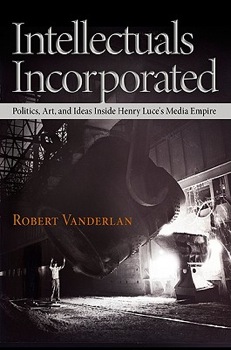 Michael Kimmage in New Republic on Robert Vanderlan’s book, Intellectuals Incorporated: Politics, Art and Ideas inside Henry Luce’s Media Empire.
Michael Kimmage in New Republic on Robert Vanderlan’s book, Intellectuals Incorporated: Politics, Art and Ideas inside Henry Luce’s Media Empire.
“Vanderlan’s subject is ‘the interstitial intellectual,’ neither fully autonomous nor coercively employed. Such a subject requires him to trace a historical trajectory. American intellectuals veered toward bohemian autonomy in the 1920s, decrying the pursuit of money as vulgar. Then came the Great Depression. Not only had the imperative of making money, or making a living, grown unforgiving, but the cherished autonomy of the 1920s could be experienced over time as unwanted solitude. The paradigmatic example, for Vanderlan, is the poet-intellectual Archibald Macleish, who took a job at Time in the late 1920s because it offered him a regular income, and also because he ‘was frustrated by his isolation.’ Time and Fortune put him in the company of tens of thousands of readers. Vanderlan demolishes the cliché that intellectuals ceased being intellectuals by writing for Time or Life or Fortune. In the 1930s and 40s, mass-media journalism and the life of the mind merged in the offices of Luce’s empire, with significant consequences for American journalism and intellectual culture. James Agee smuggled ‘his own vision of journalism into Luce’s magazine.’ John Hersey, Theodore White, and Whittaker Chambers pioneered a new genre of ‘political literature’ at Time. Hersey’s writing in particular can be read “as a forerunner to the ‘new journalism’ of the 1960s.”
***
 Gordon Crovitz in WSJ, "Google, Motorola and the Patent Wars".
Gordon Crovitz in WSJ, "Google, Motorola and the Patent Wars".
“The value of patents in software and hardware such as smartphones has everything to do with litigation risk. It has almost nothing to do with technology. ‘A smartphone might involve as many as 250,000 patent claims’ that are largely questionable, David Drummond, Google’s chief lawyer, wrote in a blog post earlier this month, before the Motorola acquisition. The arbitrariness of patent grants means mobile-phone operators are inevitably infringing patents, risking billions in infringement lawsuits, but they have no way to know which broad patents will be upheld and which rejected. The best and maybe only defense is a good offense…. It’s a measure of the deeply dysfunctional U.S. patent system that the most sophisticated technology companies have been reduced to investing in patents to defend themselves from one another.”
***
Matt Richtel & Jenna Wortham in NYT, "Motorola’s Identity Crisis".
“‘It’s like, thanks for everything you did in the 20th century, but you’re being bought by a search engine,’ said Roger Entner, a telecommunications industry analyst and founder of Recon Analytics, a market research firm. He added, ‘Nobody ever buys a company and leaves it alone.’ Motorola traces its beginnings to 1928, when two brothers, Paul and Joseph Galvin, started a company making power converters for household radios. In 1947 it changed its name to Motorola, after its popular car radio brand. The company produced radio phones that helped American troops communicate in World War II, car phones in the 1980s, and the trend-setting MicroTac and Razr cellphones, among other products. But in recent years, after the Razr’s popularity faded, Motorola flirted with financial doom. It was only in the last few quarters that it surged back under the leadership of Sanjay Jha, a former executive at Qualcomm, who joined Motorola in 2008 when it was in danger of missing the rise of the smartphone.”
***
 Bee Wilson in London Review of Books on Ruth Barton’s book, Hedy Lamarr: The Most Beautiful Woman in Film.
Bee Wilson in London Review of Books on Ruth Barton’s book, Hedy Lamarr: The Most Beautiful Woman in Film.
“Frequency hopping became a basic technology for military communications: it is used, for example, in the Milstar system that controls all US intercontinental missiles. But its civilian application is most significant. Spread-spectrum -- in which signals are deliberately spread across a wide band-width to ensure privacy -- is the basis of much of our current telecommunications system, from mobile phones to wireless broadband. Over the past couple of decades, Lamarr‘s films have been ignored, but her reputation as an inventor has risen. She and Antheil were not the first or the only people to devise versions of frequency hopping…. But it is still pretty jaw-dropping that Lamarr, who left school at 16, should have come up with the essential concept by herself. Inventors‘ Day in Europe is now celebrated on her birthday, 9 November.”
***
Charles Recknagel at Atimes.com, "Persian classic too sexy for censors".
“The Ministry of Culture and Islamic Guidance decided that some parts of the epic poem Khosrow and Shirin by Nezami Ganjavi needed reworking, despite the fact that the book-length masterpiece has been a classic of Iranian literature for 831 years. The news not only astounded the publishing house, which had expected routine approval when it sought to publish its eighth edition of the book, it also shocked Iran's intellectual class, despite decades of inurement to the censors' heavy hand. ‘This poem existed for nine centuries and ... Iranians were Muslims during those nine centuries,’ says Iran's best-known contemporary female poet, Simin Behbahani. ‘No one [during that time] had any objections to [the] Khosrow and Shirin poem and didn't think of censoring parts of the poem ... Nothing would be left [of the poem] by now, if they had. Those who talk about censoring the poem should be ashamed.’ The Ministry of Culture and Islamic Guidance has given no official explanation for its decision to belatedly censor the epic. But one objection reportedly concerns the poem's reference to the heroine Shirin embracing a male body. That the body is that of her husband and the embrace is a key to understanding her suicide at the end of their tragic love story seems not to have mattered one bit to the censors.”
***
 Eamon Duffy in New York Review of Books on Caroline Bynum’s book, Christian Materiality: An Essay on Religion in Late Medieval Europe.
Eamon Duffy in New York Review of Books on Caroline Bynum’s book, Christian Materiality: An Essay on Religion in Late Medieval Europe.
“‘Holy Feast’ included a characteristically sophisticated exploration of a well-known feature of the period, the abstinence by Saint Catherine of Siena and many other holy women from ordinary food, and their reliance for survival instead on the regular reception of holy communion. Other historians had interpreted this bizarre and radical asceticism through modern medical categories, seeing in it a form of ‘holy anorexia,’ evidence of a morbid and dysfunctional sensibility, driven by an internalized misogyny and self-loathing determination to punish the body and eliminate female sexual characteristics. Bynum, while not altogether discounting such explanations, argued against the anachronistic reductionism of modern medical or psychoanalytical readings of complex medieval behaviors and beliefs. She emphasized the special links between these women and the Eucharist, and pointed to the many ways in which the manipulation of food in sacred settings gave them control and direction over their own lives and environments, and established a privileged space for them in an institution otherwise dominated by male concerns and male authority.”
***
 Geoffrey Hosking in London Review of Books on Wayne Dowler’s book, Russia in 1913.
Geoffrey Hosking in London Review of Books on Wayne Dowler’s book, Russia in 1913.
“Another threat to civil society, according to Dowler, was posed by the various Symbolist and Futurist aesthetic movements. His view is provocative, given their high reputation among contemporary Russianists. As he sees it, the Symbolists and Futurists favored free speech, but only so that they could disseminate their own intolerant and authoritarian visions of how to change the world. They despised the market economy and the consumerist aspirations of the masses. Some of them deployed a deliberately violent rhetoric. In December 1912, for example, the self-proclaimed Cubo-Futurists -- Mayakovsky, Khlebnikov et al -- published a manifesto entitled ‘A Slap in the Face of Public Taste,’ in which they called for ‘Pushkin, Dostoevsky, Tolstoy etc, etc‘ to be thrown overboard from the steamer of modernity’. They and those like them, as Dowler puts it, ‘lionized the strong and independent personality but deplored a rights-based individualism’. In general, their apocalyptic visions and extravagant language helped to poison public discourse in the years before 1917.”
***
Holland Cotter in NYTBR on Hunter Drohojowska-Philp’s book, Rebels In Paradise: The Los Angeles Art Scene and the 1960s.
“The story starts in 1955, when Los Angeles was a boomtown thanks to movies and the aerospace industry, but a cultural backwater. There were plenty of homegrown artists, but few galleries and no modern art museum. Into this bare terrain came a couple of driven personalities. One of them, Walter Hopps, preppy and bespectacled, was a college dropout and art addict. The other, Edward Kienholz, was a bearish farm boy-artist with a peppery temperament. On the surface, their alliance was an unlikely one — Mr. Peepers meets Bigfoot — but it worked. Both wanted to get some art action going in the city, and in 1957 they pooled their meager resources to open the Ferus Gallery. Initially conceived as a showcase for local talent, Ferus expanded its scope after an early shift in personnel. Kienholz bailed; he really didn’t want to run a business. Hopps, a person of pathologically impractical habits, didn’t know how to. So when an amiable former actor and New York transplant named Irving Blum turned up and bought out Kienholz’s share, he became the gallery’s functional director and made its range of artistsbicoastal. These three men are recurrent figures in Drohojowska-Philp’s narrative, which pans back and forth in time. Around them, or around Ferus, circulated a constellation of figures who would become the city’s first glamorous art stars, among them John Altoon, Larry Bell, Billy Al Bengston, Robert Irwin, Craig Kauffman, Ed Moses, Ken Price and a young Oklahoman, Ed Ruscha. The Ferus scene, as described in the book, started out fairly relaxed and mildly countercultural. Even its hardest-working members put in serious surfing time. After all, why worry about shows and sales if there was no market?”
***
Dave Kehr in NYT, "Streaming Video’s Emerging Bounty".
“Both Netflix and Hulu are full of hidden gems, but often it’s not easy to dig them out. Somewhere on Netflix, between Ashley Tisdale in Sharpay’s Fabulous Adventure and Christopher Walken and Jennifer Beals in The Prophecy II, there’s a very good copy of Edgar G. Ulmer’s 1948 film noir Ruthless in its full 105-minute version, rather than the 88-minute public domain cut that’s been the only edition available for years. To find it, though, you have to know it’s there. One useful service is instantwatcher.com, an independent Web site that monitors the Netflix streaming library (and has a beta site up for Hulu, at instantwatcher.com/hulu, that for the moment only covers Hulu’s free, commercially supported programming). Instantwatcher keeps track of the new releases on Netflix, as well as those about to expire, and offers several searchable sub-indexes: pages devoted to various genres, languages and years of release; lists of films recommended by Rotten Tomatoes and the critics of The New York Times (including links back to The Times’s reviews). Streaming video will probably never live up to the utopian dream of many cinephiles: the notion that every movie ever made will suddenly be available with the click of a mouse. Neither Netflix nor Hulu is particularly friendly toward older films. Instantwatcher reports only 26 Netflix streaming titles for the banner year 1939, more than half of them B westerns (but also One Third of a Nation, a fascinating and quite rare offshoot of the Federal Theater Project’s Living Newspaper Unit).”
***
Jonathan Foltz at LAreviewofbooks.org on Malcolm Turvey’s book, The Filming of Modern Life: European Avant-Garde Film of the 1920s.
“No film better demonstrates the conflicted status of avant-garde cinema than Francis Picabia and René Clair’s collaborative Dada document, Entr’acte, which opens with a note of overt defiance, if not aggression, towards its audience. In the initial shots, Picabia and Erik Satie (who composed a score for the film) descend from the air in slow motion to aim and fire a canon directly into the lens of the camera. Dressed in formal attire, the two gentleman pause before lighting the fuse and appear to hold a reasoned discussion as to how to proceed, motioning to each other as if carefully weighing their options. Then Satie lifts the missile from off-screen, holding it out for them both to smell; only upon finding the odor repugnant does Satie load it into the canon and fire into our direct line of sight. It is a manifestly destructive gesture that bluntly taunts both the good taste and apparent safety of its spectators (whose original members were attending one of Satie’s productions at the Swedish ballet in Paris). Clair would later wax nostalgic for the shock the film had on its audience, remarking in his book Cinema Yesterday and Today (1970):
“Now that Entr’acte is shown in film societies and film libraries with all the deference due to an antique, I am tempted to pay my respects to those who once hissed it. …Nothing is more distressing than a tame, disciplined audience that feels obliged to applaud in cadence even what it finds dull, even what it dislikes.’”
***
Juliane Lorenz at LAreviewofbooks.org on Rainer Werner Fassbinder.
“Fassbinder had invented some rather oddball characters for Eight Hours Don’t Make A Day, such as the old couple, Grandma and Grandpa, who still had sex, came up with inventive schemes, and generally behaved more like young kids than old people. After dinner every day they drank a little schnapps and discussed the world and the problems of their grandchildren very openly. The series also dared to portray unalienated workers who showed initiative, who thought about how to communicate with their bosses and foremen, who actually tried to increase the amount of time they worked and to produce more quickly so that the owner of their factory could make more money, and who offered suggestions as to how they could also benefit from this increased productivity. Moreover, the factory boss — played by Klaus Löwitsch, a rising Fassbinder star who would soon play the lead in World on a Wire (1973) — actually accepted a number of his workers’ ideas and saw the economic benefits they offered. These were revolutionary ideas at a time when Germans were still somewhat influenced by the notion that people need a leader who tells them what to do…. Although Rainer was commissioned to write more, the series came to an abrupt end after the fifth episode. Certainly the audience was ready for more. However, politics intervened: Members of the very powerful German trade unions complained that there were no scenes in the series dealing with their issues and wanted the stories changed. Why, they wanted to know, was Fassbinder not including their stories as working-class representatives? From the outset, Rainer and Peter Märthesheimer’s idea had been to tell stories of working class people who wanted to solve their problems for themselves. Nevertheless, in the new scripts Rainer included the issues trade unionists had wanted to see focused on. But when Günter Rohrbach read the three new episodes he found the stories too artificial, and as a result they were never filmed.”
***
Victor Griffin (Pentagram) interviewed by Ron Holzner (Trouble) in Reader.
“You've got a five-disc CD player in your car. What five CDs are you gonna put in it?
Right now I actually have a six-CD changer in my car. I have Creedence Clearwater Revival, I have the new Pentagram album, I have the new Place of Skulls album, I have "Steppenwolf 7", I have Alice Cooper "Love It to Death", and I think I have an empty space.
It's a shame that Steppenwolf got lost in the shuffle where people just know a couple of songs. They've got so many good ones, like ‘The Pusher.’ As a kid, I didn't know what the song was about; I just thought it was a cool tune. But as I got older, it's just like, ‘Man, this song is heavy.’
Well, they're a really blues-based band and they're sort of an acquired taste, other than the obvious radio songs like ‘Magic Carpet Ride’ and ‘Born to Be Wild.’ They're one of those bands where a lot of people would buy the album for the hit song and think the rest of the album sucked. You and I come from the same school. We're album guys, we're not radio-play guys.”
***
Obituary of the Week
• Raul Ruiz (1941 - 2011)
“As a boy, he steered clear of the local movie house that showed serious Mexican, French and Italian films, favoring the theater that showed Flash Gordon serials and cowboy movies. He began writing plays at a furious rate while still a teenager, and although he studied law and theology at the University of Chile, he gravitated toward the film club and the department of experimental film. After spending a year at the film school run by Fernando Birri in Santa Fé, Argentina, he worked as an editor on television news programs in Chile and as a scriptwriter for soap operas produced by Televisa in Mexico, an experience reflected in his career-long fascination with popular culture and the conventions of serial narrative. Mr. Ruiz came of age as a filmmaker soon after the socialist politician Salvador Allende was elected president of Chile in 1970. He had already built a small reputation for his first feature, the experimental sociopolitical comedy ‘Three Sad Tigers,’ which won the top prize at the Locarno International Film Festival in 1969. In an interview with Bomb in 1991, he called it ‘a film without a story,’ describing it in terms that indicated his natural bent toward artistic subversion. ‘All the elements of a story are there but they are used like a landscape, and the landscape is used like story,’ he said.”
***
Thanks to Jay Babcock, Steve Beeho.

To receive a weekly update notice for the NV, send an email to newvulgate[at]sbcglobal.net with SUBSCRIBE in the subject line. To stop receiving notices, do the same with the word UNSUBSCRIBE.
• The New Vulgate
• Joe Carducci, Chris Collins, James Fotopoulos, Mike Vann Gray, David Lightbourne
• Copyright retained by the writer, artist, or photographer


 In 1981 KROQ was still playing a lot of tunes off of Los Angeles punk records. When we got the “Damaged” album out they were playing “Rise Above,” “TV Party,” “Six Pack,” “Thirsty and Miserable,” “Police Story,” and “Gimmie Gimmie Gimmie.” The station also played deeply into albums by X, the Adolescents, the Circle Jerks and others. But come 1982 KROQ tightened up around the rock-is-dead Brit-pop that followed Malcolm McLaren rather than the Sex Pistols themselves. These synth-based New Romantic groups at most used guitars to create washes and textures that could done to by engineers in a way that expressive playing could not. Such sounds sit still and bear more echo, eq’ing, and other outboard wonder-toys. By mid-82 we no longer listened to KROQ at SST. If rock stations were on it was usually KMET or KLOS, so we had a working knowledge of the beginnings of hair metal. In October 1981 while the Meat Puppets first album was being worked on at the Unicorn studio Daphna brought in a test pressing of the still unreleased first Motley Crue album. Chuck and Greg and Laurie O’Connell (of Monitor, then working at Unicorn) knew of Nikki Sixx’s earlier band London which had been a Hollywood glam failure, and so they were interested even though the new band was barely known. We listened to it a couple times in the studio and talked about whether or not it was a piece of shit and/or whether Unicorn should release it. Who knows what Daphna was really doing but the band’s management was hoping for a major deal and couldn’t get one. The impending “Damaged” release had made Unicorn a logical plan B, especially since her other signings were commercially intended AOR / CHR pop (Joe Chemay, J.D. Drews, Frankie Blue). I only liked the last tune, “Piece of Your Action,” which had a lower-pitched, less hysterical riff and the band managed to more-or-less pull it off. The album came out in November on a self-released label through Greenworld (the distributor was just beginning to reorient themselves toward releasing records ultimately as Enigma). The release made a splash and Elektra picked it up a few months later.
In 1981 KROQ was still playing a lot of tunes off of Los Angeles punk records. When we got the “Damaged” album out they were playing “Rise Above,” “TV Party,” “Six Pack,” “Thirsty and Miserable,” “Police Story,” and “Gimmie Gimmie Gimmie.” The station also played deeply into albums by X, the Adolescents, the Circle Jerks and others. But come 1982 KROQ tightened up around the rock-is-dead Brit-pop that followed Malcolm McLaren rather than the Sex Pistols themselves. These synth-based New Romantic groups at most used guitars to create washes and textures that could done to by engineers in a way that expressive playing could not. Such sounds sit still and bear more echo, eq’ing, and other outboard wonder-toys. By mid-82 we no longer listened to KROQ at SST. If rock stations were on it was usually KMET or KLOS, so we had a working knowledge of the beginnings of hair metal. In October 1981 while the Meat Puppets first album was being worked on at the Unicorn studio Daphna brought in a test pressing of the still unreleased first Motley Crue album. Chuck and Greg and Laurie O’Connell (of Monitor, then working at Unicorn) knew of Nikki Sixx’s earlier band London which had been a Hollywood glam failure, and so they were interested even though the new band was barely known. We listened to it a couple times in the studio and talked about whether or not it was a piece of shit and/or whether Unicorn should release it. Who knows what Daphna was really doing but the band’s management was hoping for a major deal and couldn’t get one. The impending “Damaged” release had made Unicorn a logical plan B, especially since her other signings were commercially intended AOR / CHR pop (Joe Chemay, J.D. Drews, Frankie Blue). I only liked the last tune, “Piece of Your Action,” which had a lower-pitched, less hysterical riff and the band managed to more-or-less pull it off. The album came out in November on a self-released label through Greenworld (the distributor was just beginning to reorient themselves toward releasing records ultimately as Enigma). The release made a splash and Elektra picked it up a few months later.
 •
• 
 •
• 
 Gregory Karp in
Gregory Karp in  Ira Stoll at
Ira Stoll at 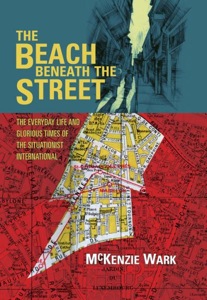 Edwin Heathcote in
Edwin Heathcote in 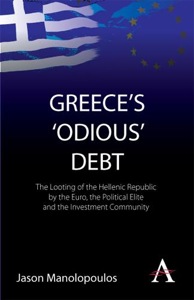 James Pressley at
James Pressley at  John Lloyd in
John Lloyd in 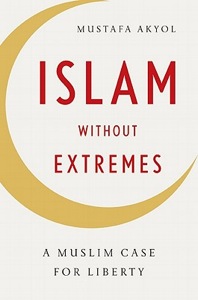 Matthew Kaminski in
Matthew Kaminski in  J.R. McNeill in
J.R. McNeill in 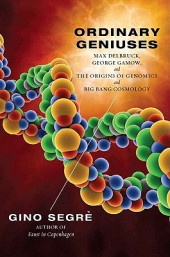 Jeremy Bernstein in
Jeremy Bernstein in  Dave Kehr in
Dave Kehr in  Jeff Nelson:
Jeff Nelson:
